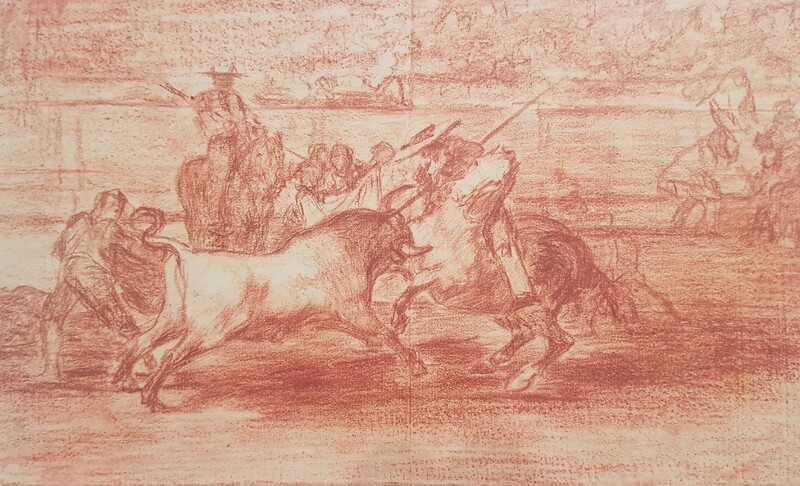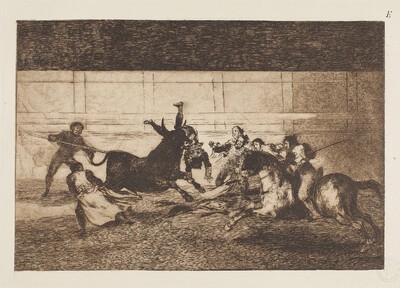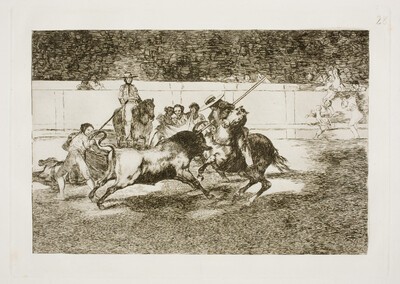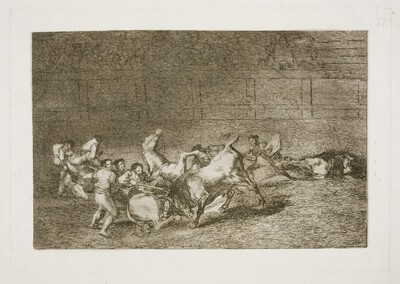- Cronología
- Ca. 1814 - 1816
- Ubicación
- Hamburger Kunsthalle, Hamburg, Germany
- Dimensiones
- 187 x 313 mm
- Técnica y soporte
- Watercolor on ivory
- Reconocimiento de la autoría de Goya
- Documented work
- Titular
- Hamburger Kunsthalle
- Ficha: realización/revisión
- 02 Oct 2021 / 22 Jun 2023
- Inventario
- (Inv. 38534)
- Otros títulos:
-
See How the ancient Spaniards hunted bulls on horseback in the countryside.
Line of provenance: [José Atanasio Echeverría, Mexico]; Julian Benjamin Williams, Seville (d. 1866); John Wetherell (?) (d. 1865); Horatio / Nathan Wetherell (?) (until 1874); Frederick William Cosens, London (1874-1890); Sotheby's, London, auction of Frederick William Cosens' estates (11-21 November 1890); Bernard Quaritch Ltd, London (November 1890-July 1891); acquired by the Hamburger Kunsthalle on 14 July 1891.
This is one of the four preparatory drawings for Bullfighting and its Extensions held by the Hamburger Kunsthalle (28a, 32b, Ea and Ka) and one of the few of the series and its extensions not in the Prado Museum, Madrid.
See How the ancient Spaniards hunted bulls on horseback in the countryside.
Preparatory drawing of the print The hard-working Rendón stinging a bull whose fate killed him in the bullring in Madrid. The scene depicts a serious mishap during the suerte de varas, when the picadors punish the bull to weaken it. This preparatory study is very similar to what Goya would later engrave on the plate.
As in the print, we see a bullring full of spectators, although almost all of them are sketchy. Goya only goes into detail on the bull, the picador and the horse in the foreground, especially the postures of the animals, depicted in full fight. The bull is lunging towards the horse, who is turning his head to prevent the bull from charging him and ramming his horns into his neck. At the same time, we can see how the picador is also turned forwards in order to have a better posture and to thrust his pike into the bull. Surrounding the picador and the bull are a series of labourers whose mission is to remove the bull with their capes in order to drive the beast towards the other picador or to keep it away from the horse in case it attacks.
The scene gains in movement in the engraving due to the effect of the light, which gives greater depth to the sand. In the background we can see that Goya has sketched the barrier of the bullring, which some of the figures jump over.
-
Hamburg1966
-
Goya. Das Zeitalter der Revolucionen. Kunst um 1800 (1980 – 1981)Hamburger KunsthalleHamburg1980
-
Hamburg1989
-
Hamburg2001
-
Dallas2014
-
Hamburg2019
-
1946pp. 177-216, espec. pp. 203-204
-
ParísLe Club Français du Livre1963p. 123
-
Vie et ouvre de Francisco de GoyaParísOffice du livre1970p. 279, cat. 1207
-
Barcelona1974p.17
-
Dibujos de Goya, 2 volsBarcelonaNoguer1975pp. 390-391, cat. 270
-
MadridMuseo Nacional del Prado2001pp. 88-89
-
SevillaSociedad Estatal Nuevo Milenio2001pp. 290-291, cat. 76
-
www.kunsthalle-karlsruhe.de, consulted 13-04-1013-04-10




